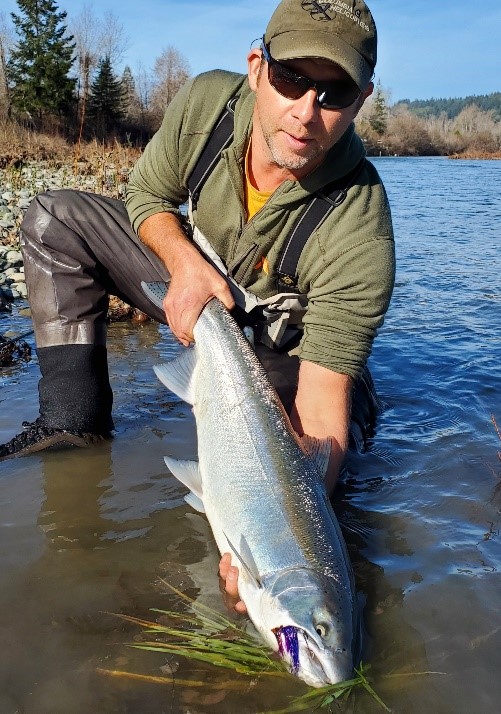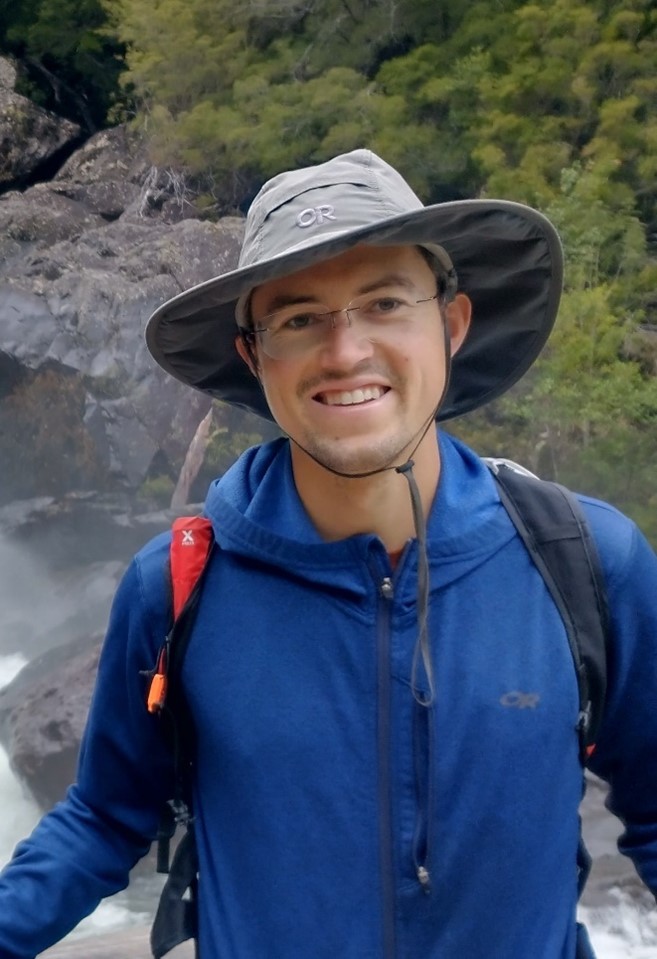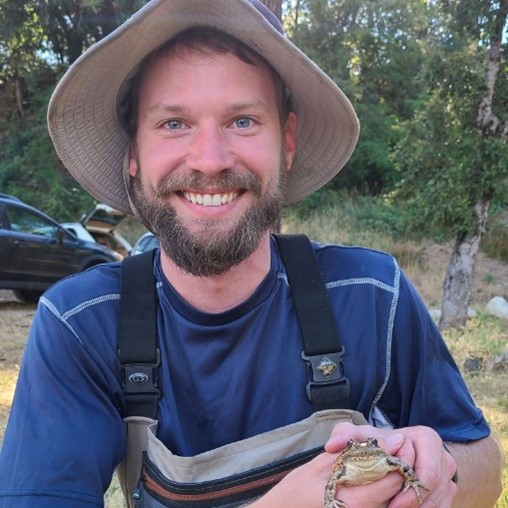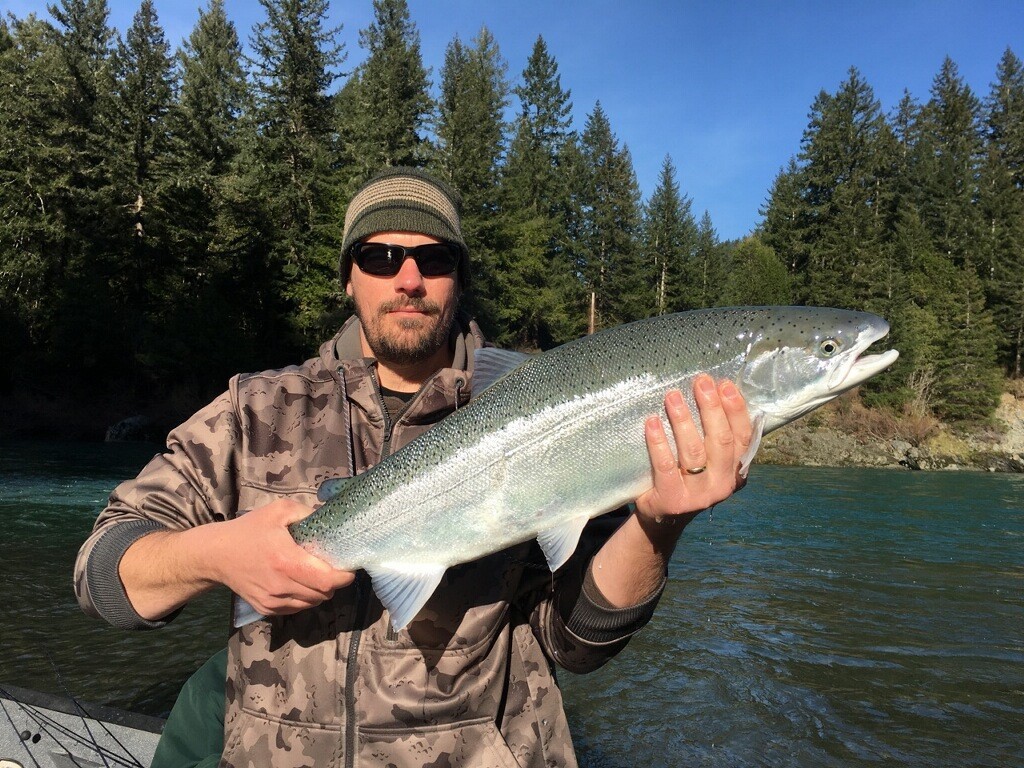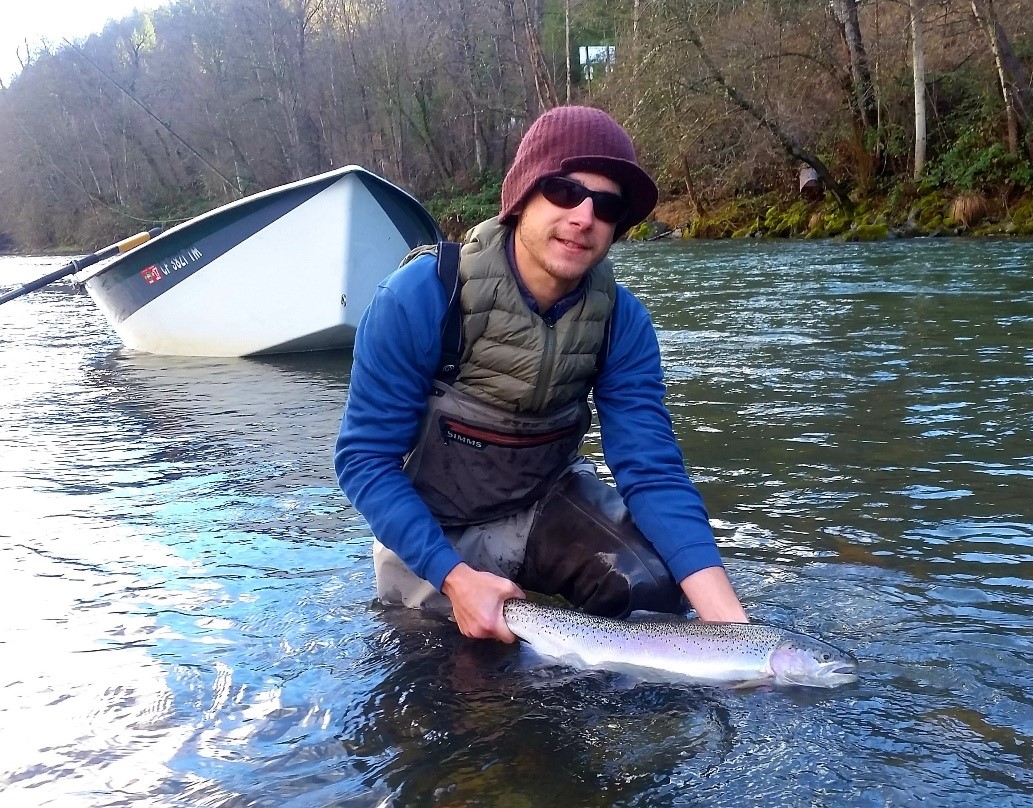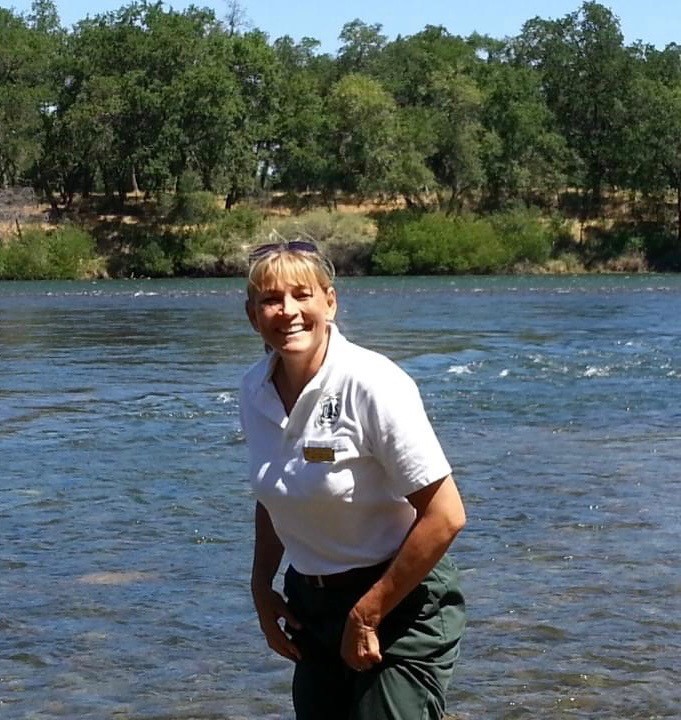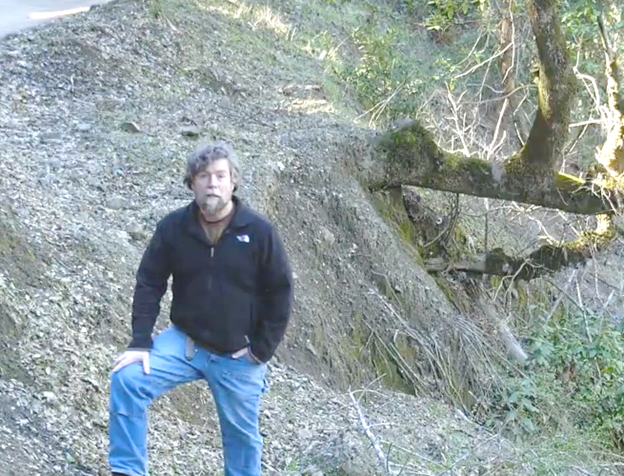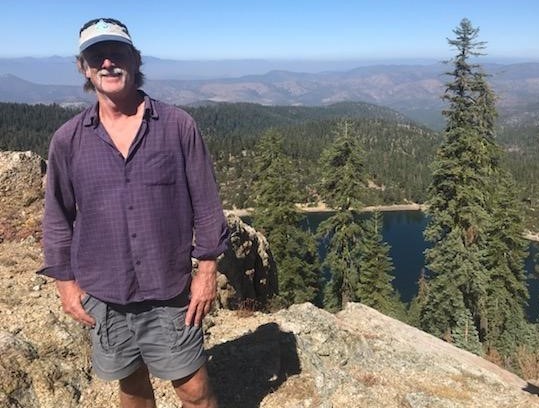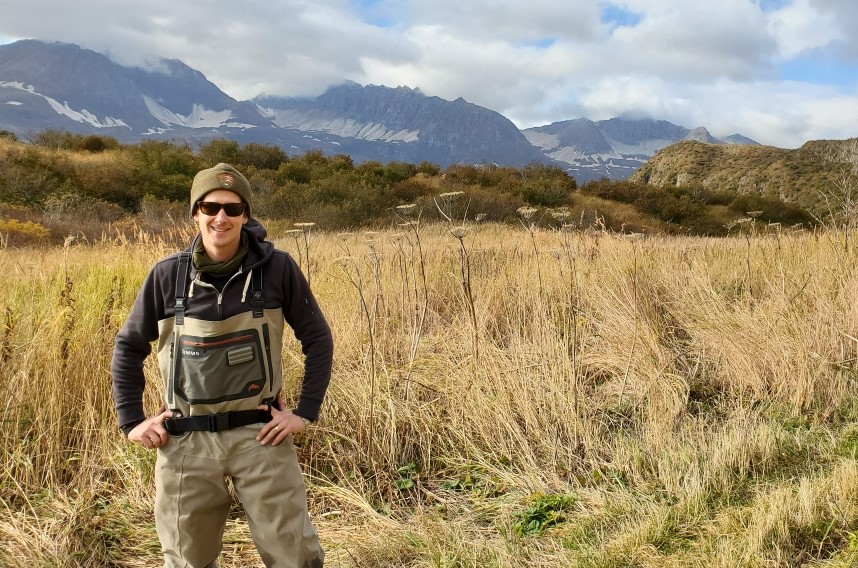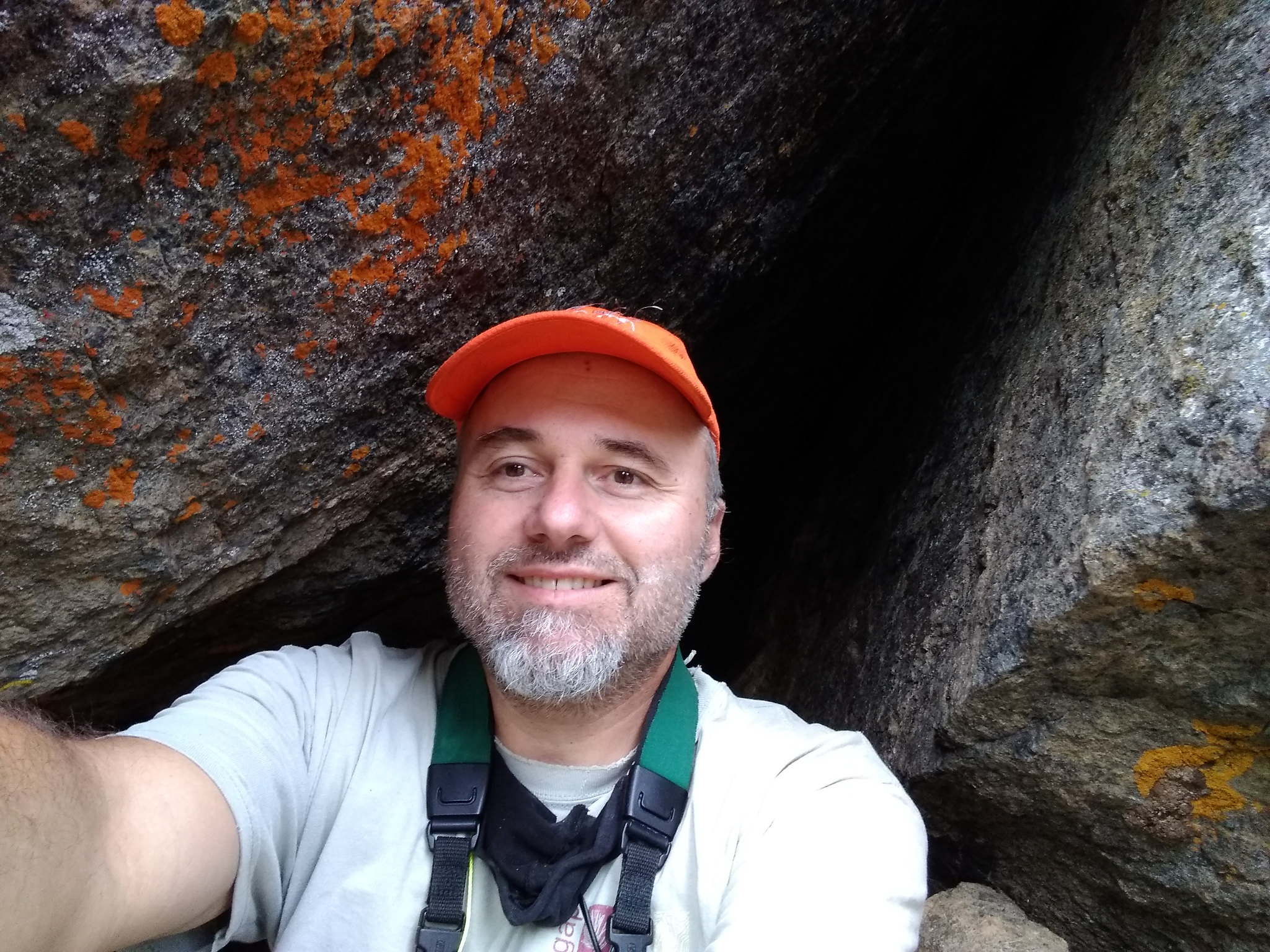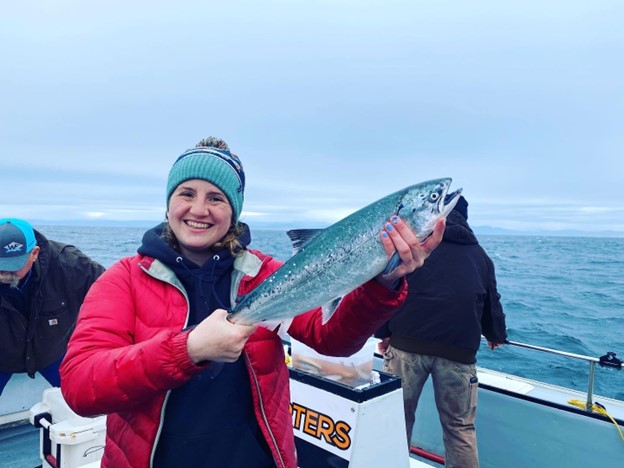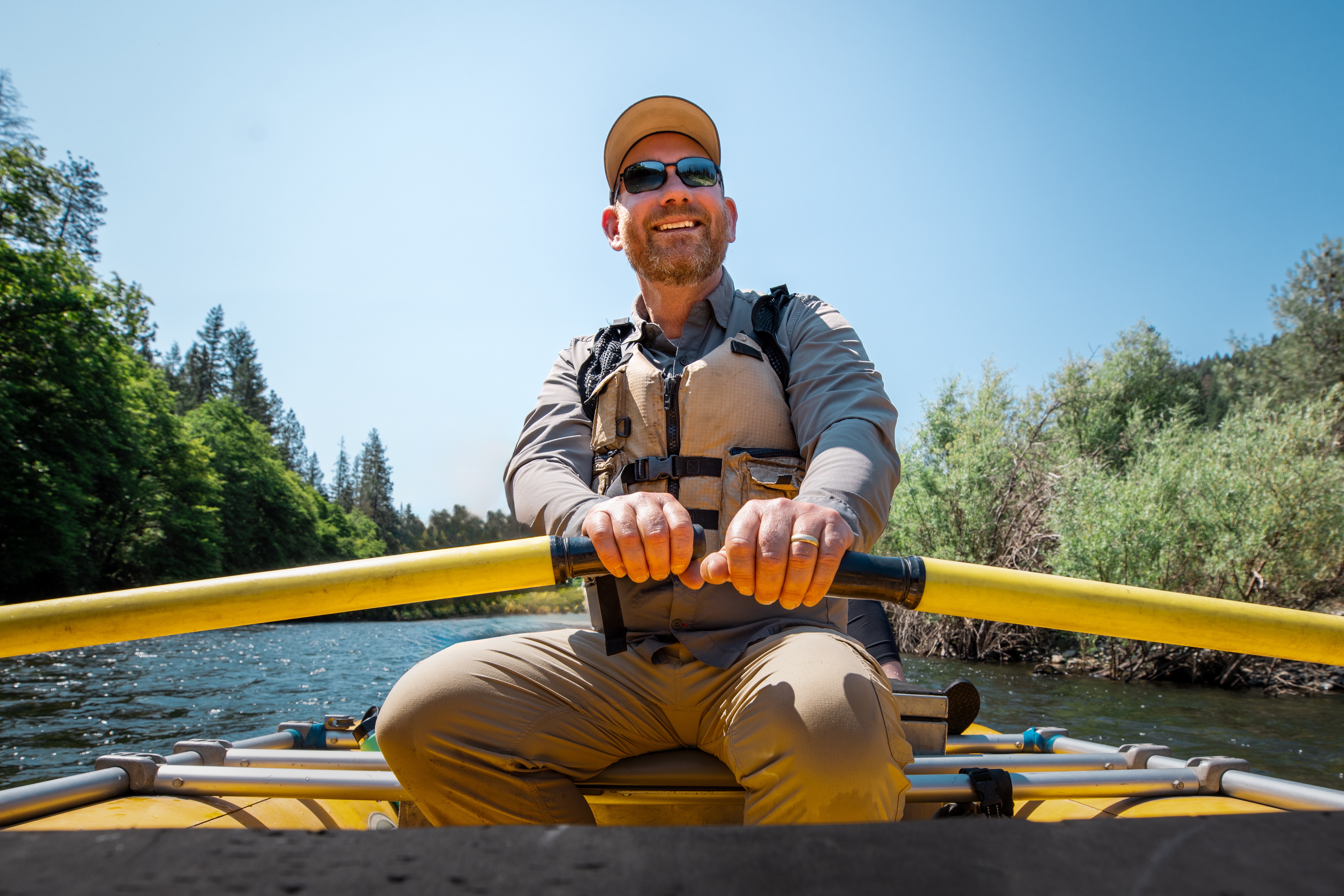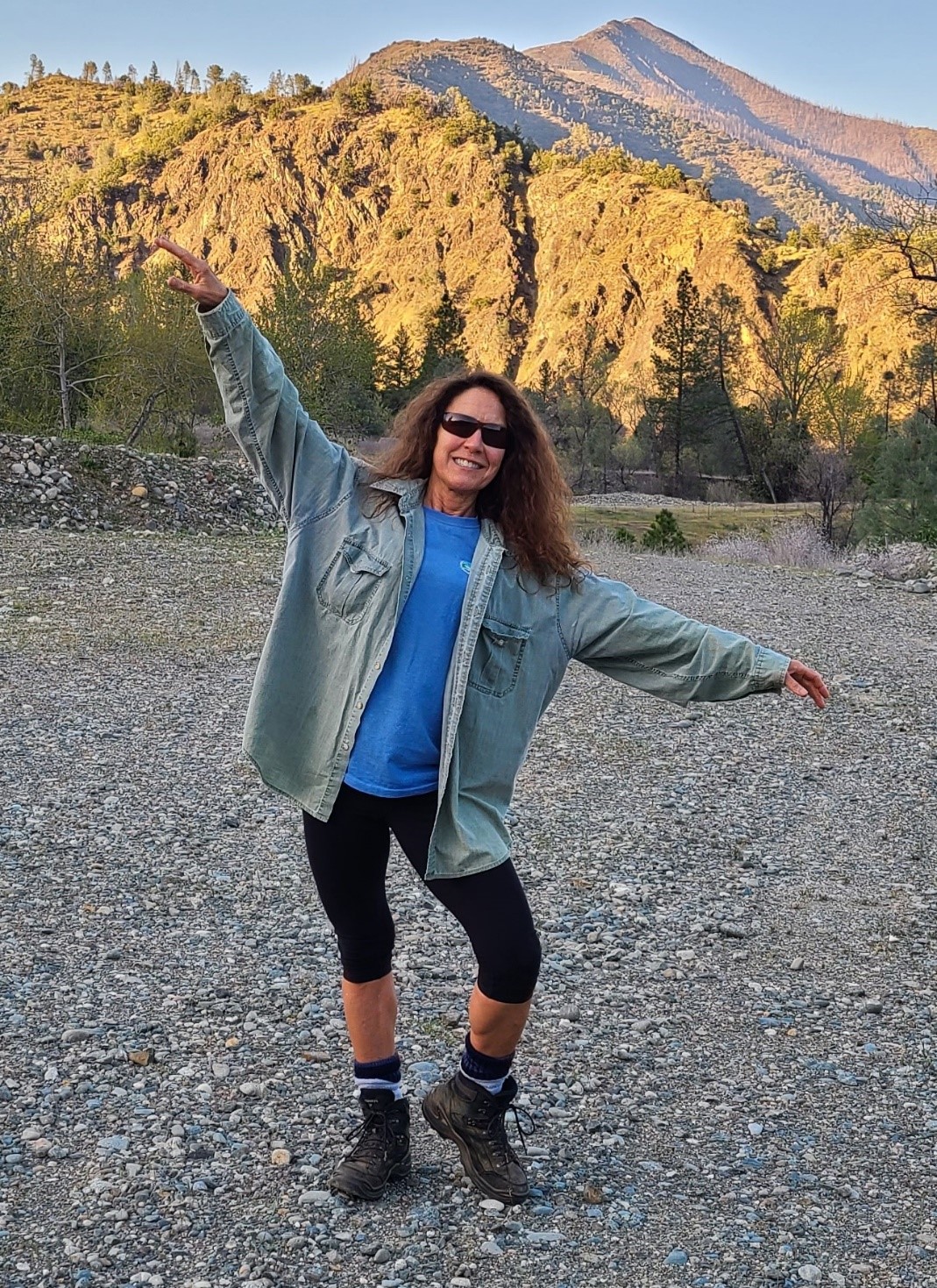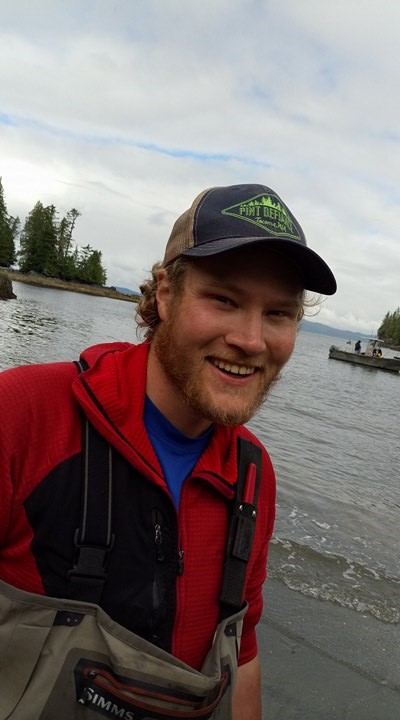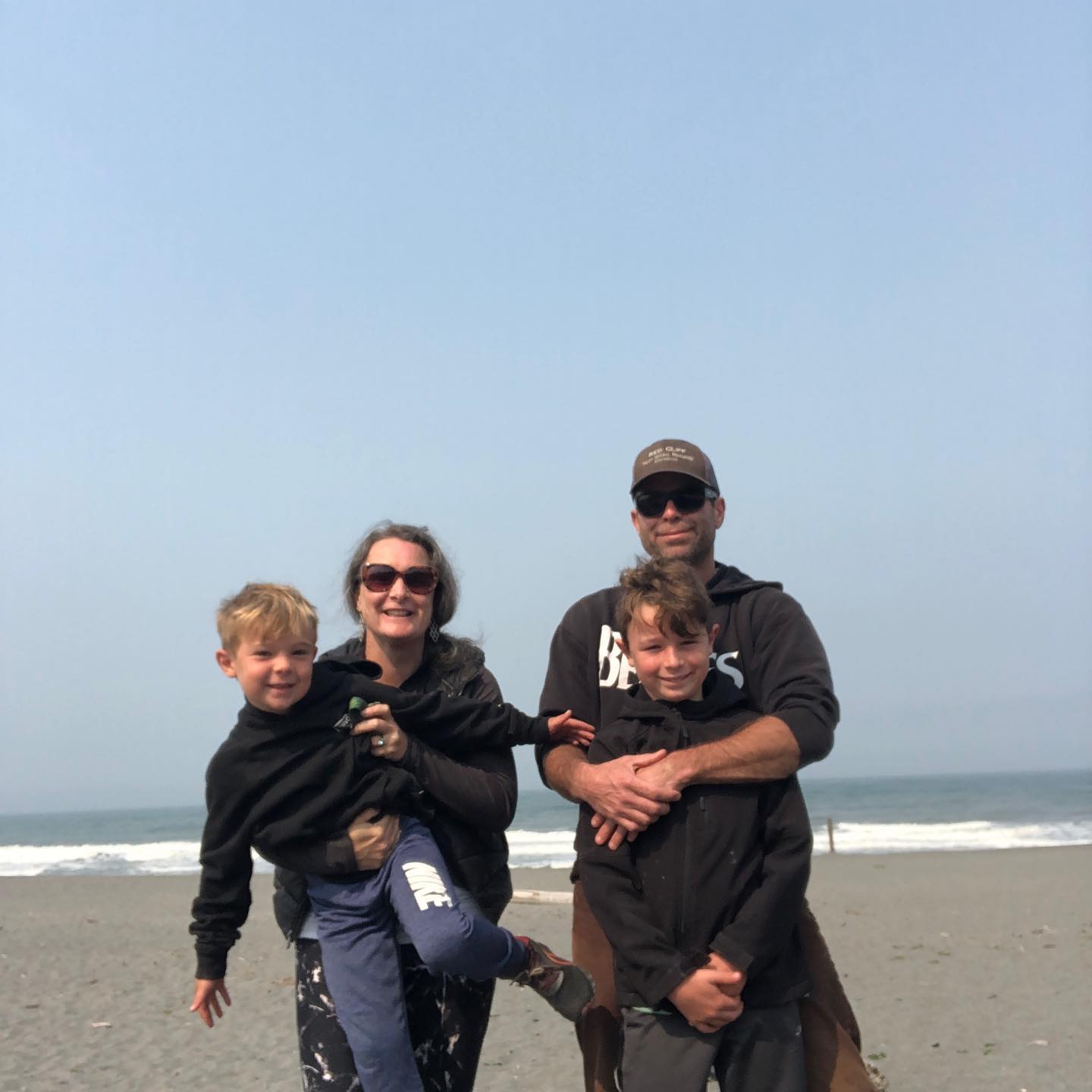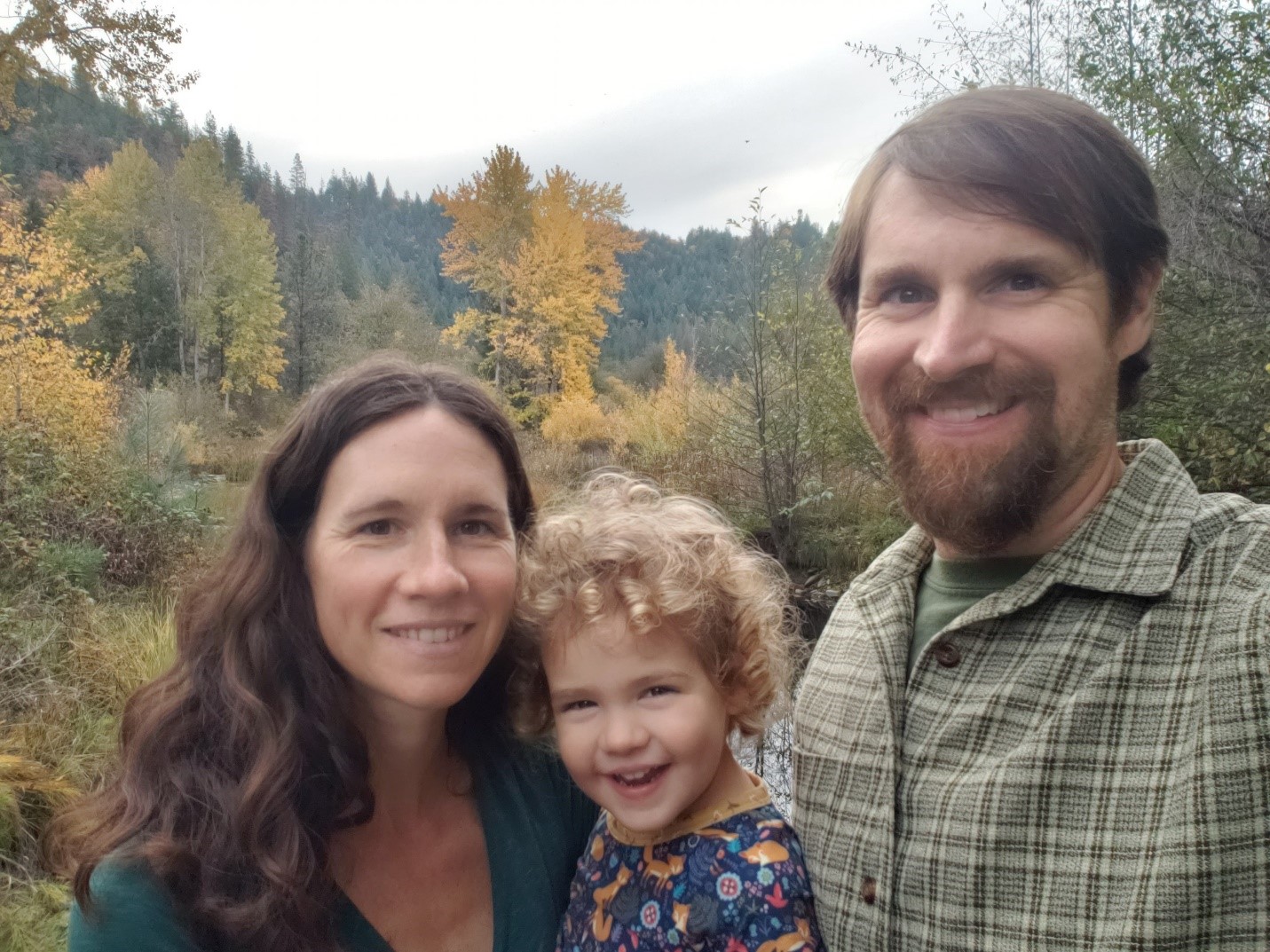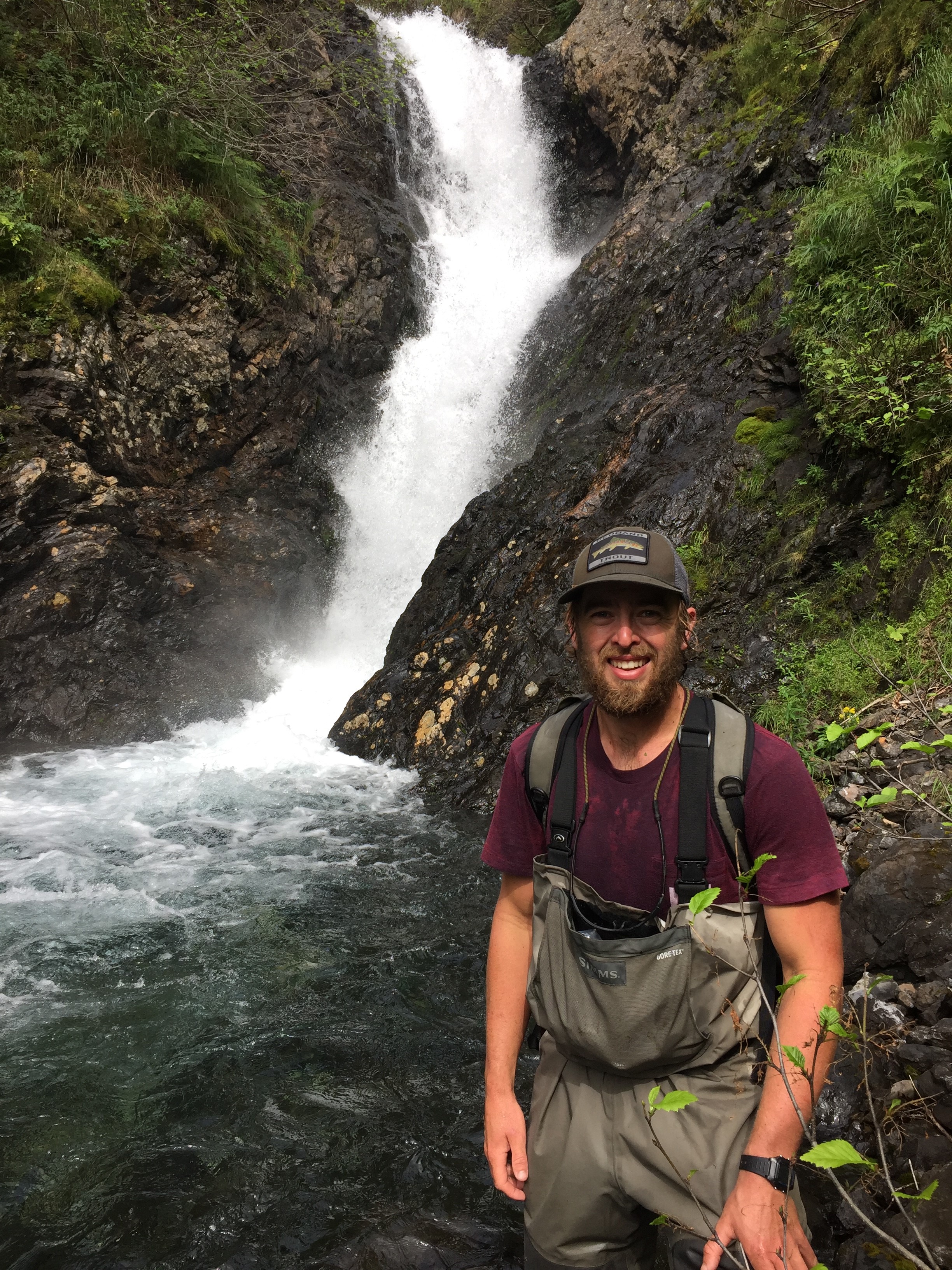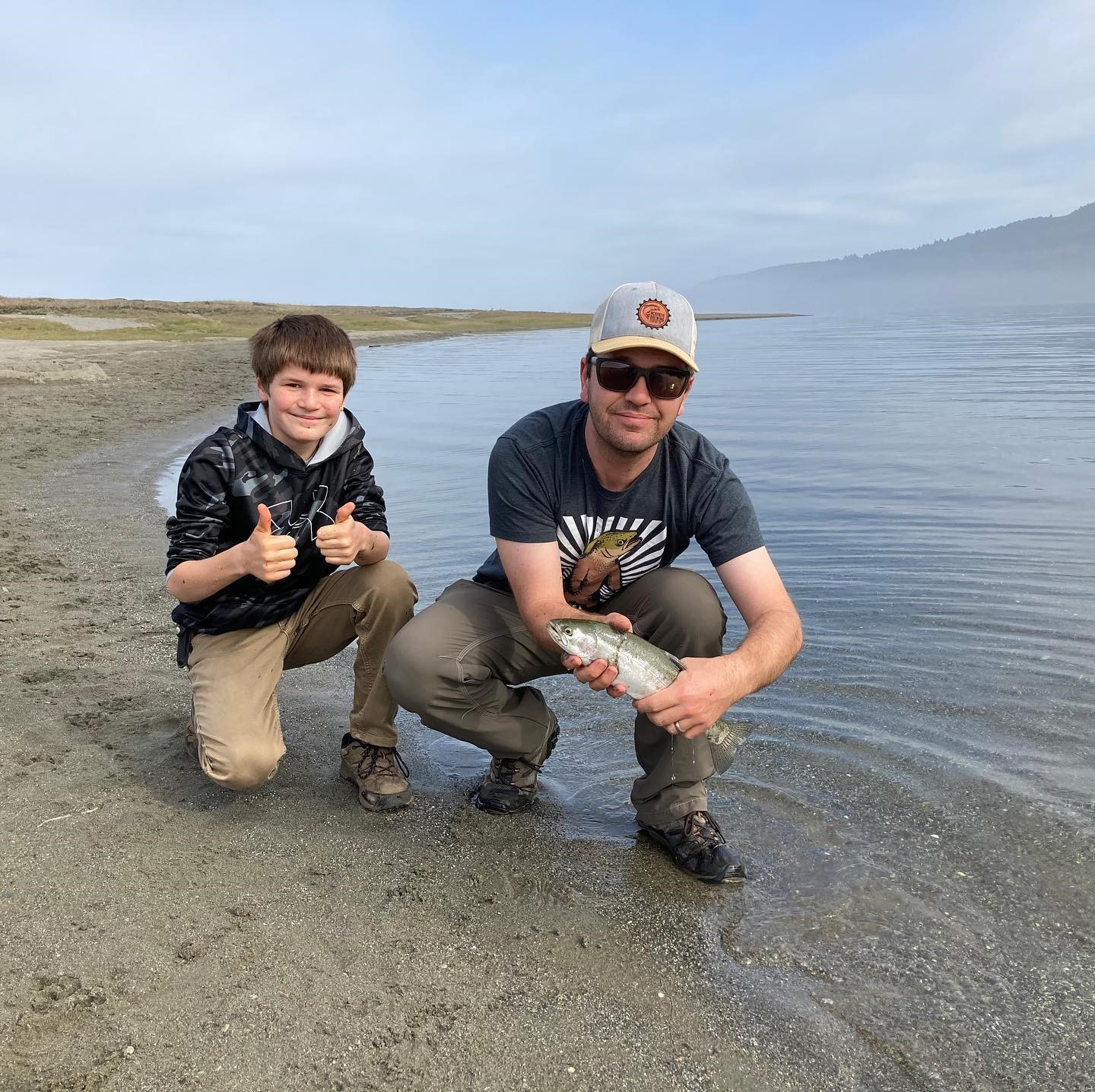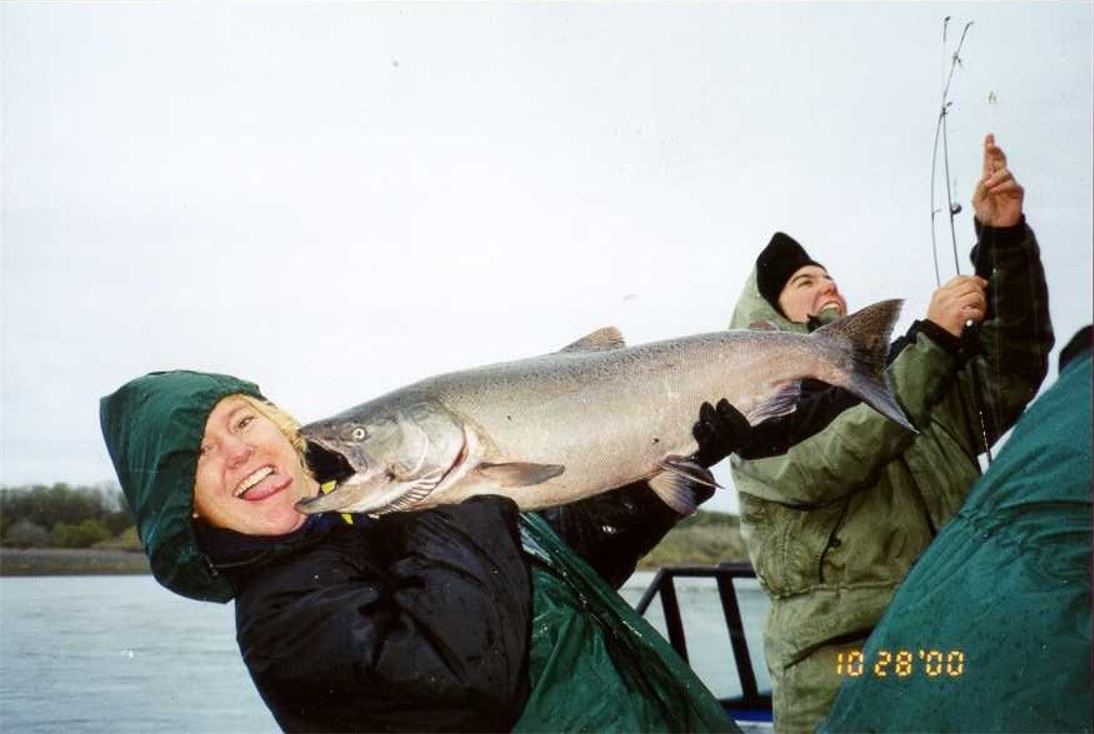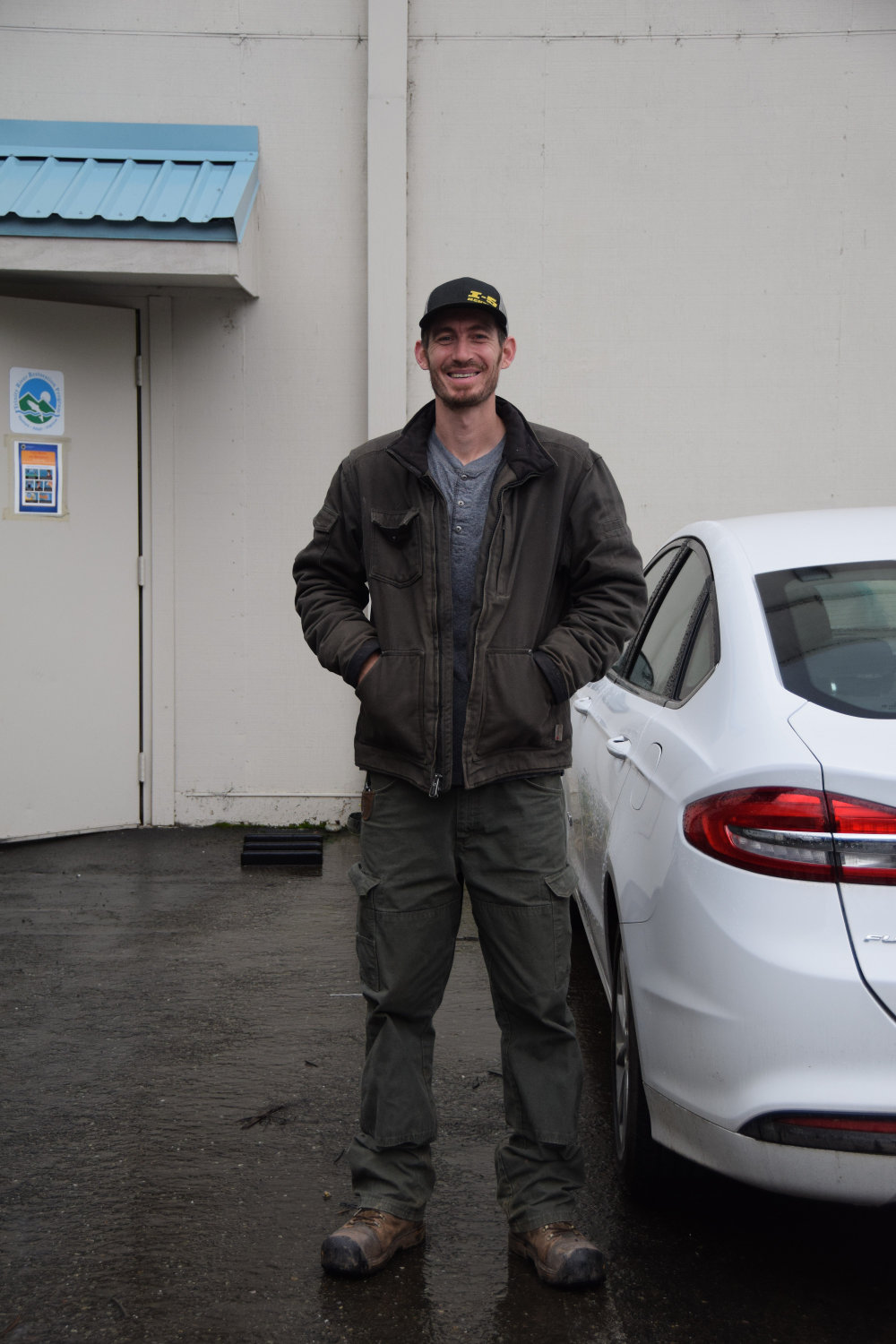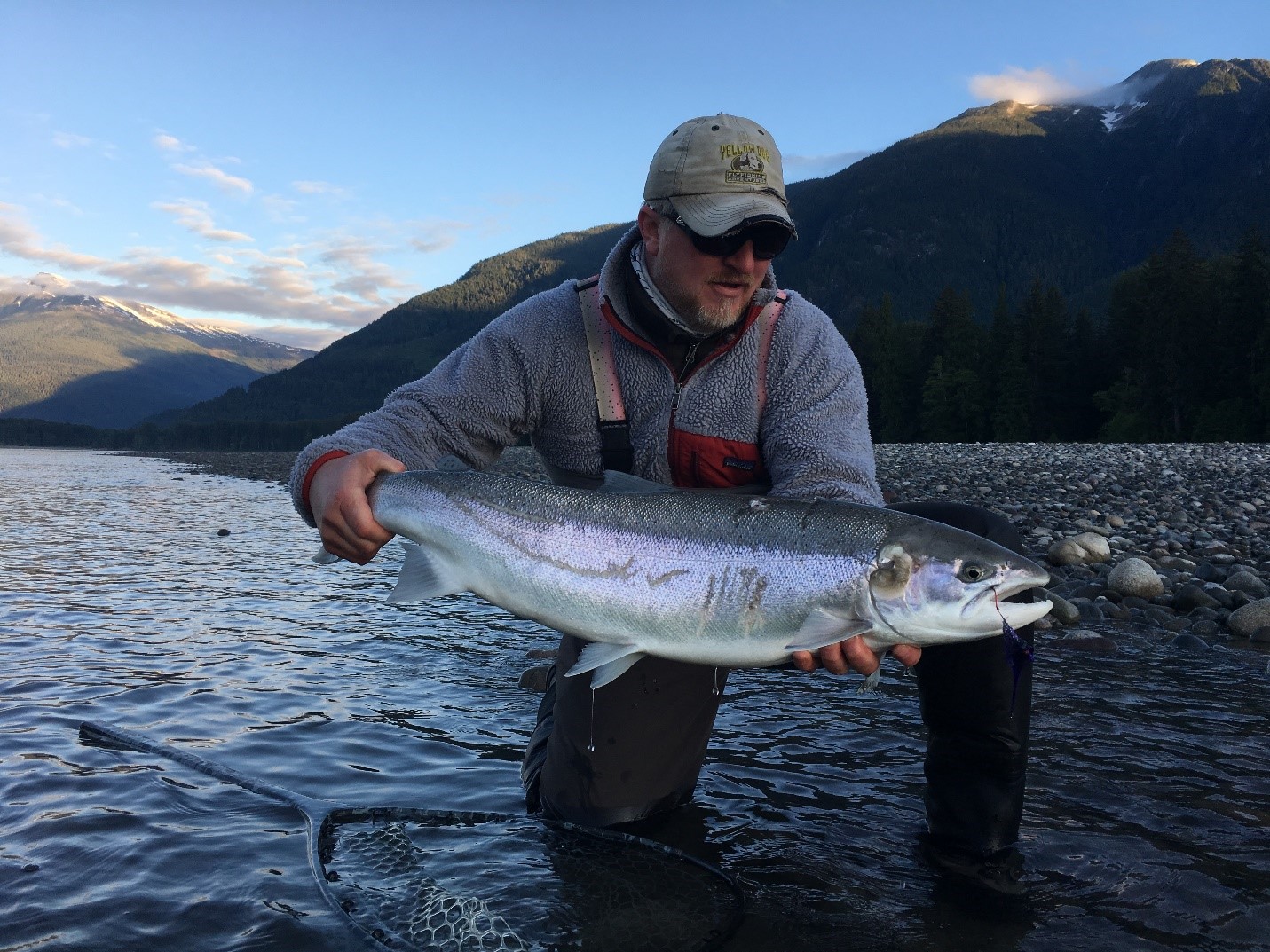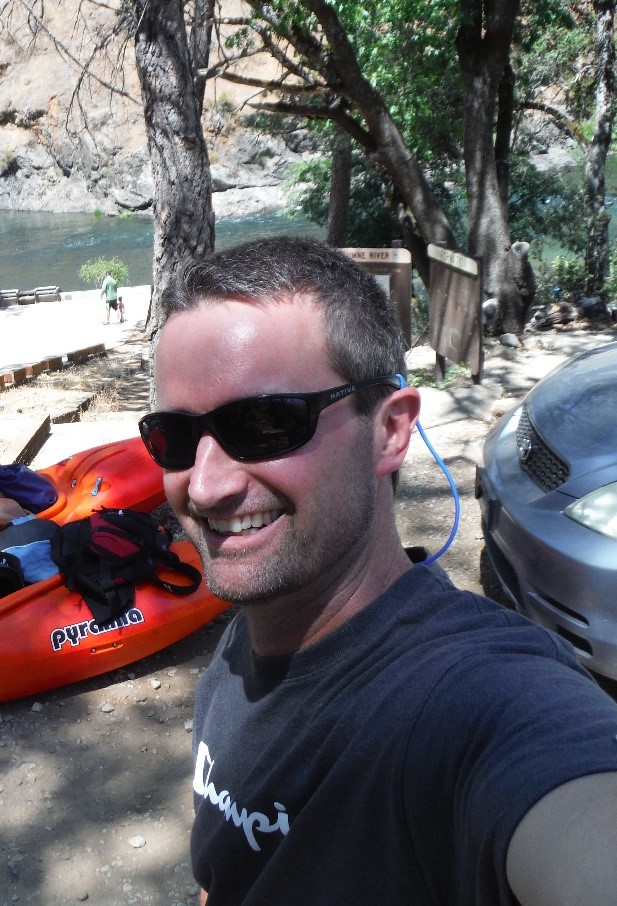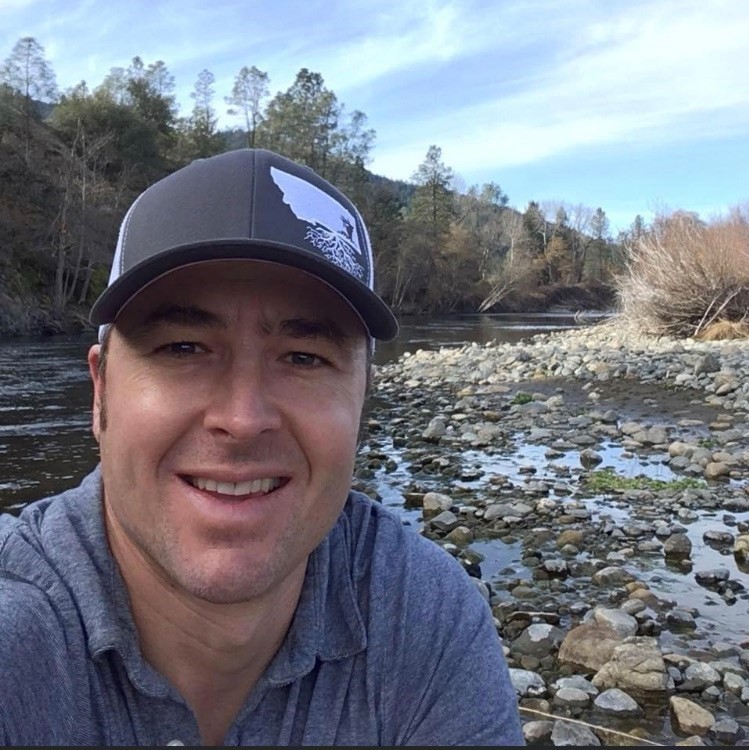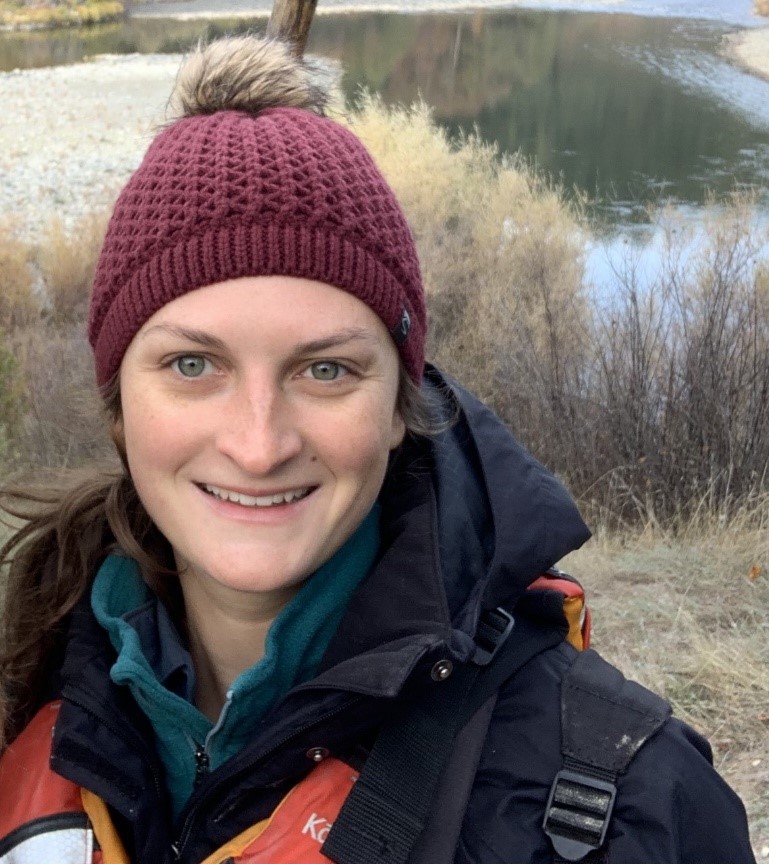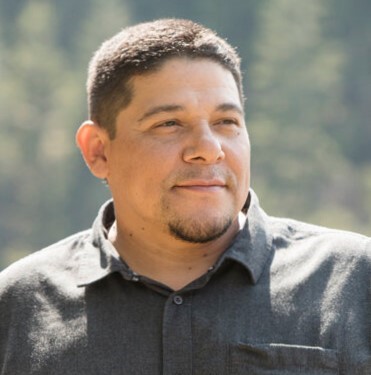Get to know us!
TRRP has a central office in Weaverville, but also includes people working in a number of offices in other communities around Northern California. It takes contributions from many individuals to guide TRRP management actions. While reaching agreement on research needs and restoration activities with many individuals involved in the process can be difficult and takes time, it removes individual priorities and optimizes our work for the river. There are ways you can get involved too!
This list includes all staff of the Weaverville office, all others who are current members of TRRP Workgroups, and a few more who work on program activities. Biographies, photos, and contact information are included only for staff who have submitted this information for public viewing. Those working in the main TRRP office in Weaverville have their names in blue.
Aaron Martin
Habitat Restoration Biologist
Yurok Tribal Fisheries Program, Arcata
Aaron has been working in the Trinity and Klamath Basin for 20 years with the Yurok Tribe. Aaron received his bachelor’s degree in Marine Biology from Dalhousie University all way back east in Halifax, Nova Scotia. That’s right, hes a Canuck….eh! Aaron moved out West in 1999 and was fortunate to work in various fisheries related positions with ODFW, EPA, and CDFW. He’s worked around rivers in all the Western United States. Aaron began working for the Yurok Tribe during the spring of 2002, the same year the fish kill occurred in the Lower Klamath. He’s helped develop and co-lead the habitat assessment efforts on the Trinity since 2005. He’s also been a primary member of the Trinity River Design Team since 2008, and has been assisting with onsite construction of Trinity River restoration projects (including wood instillation) since that time. Aaron is an avid fisherman, both fresh and saltwater. He also loves to hunt, float rivers, and chase his son up and down trails on their mountain bikes and calls Blue Lake his home.
Austin Hall
California Natural Resources Agency - Department of Water Resources
I am a Water Resource Engineer with the California Department of Water Resources, North Regional Office. I grew up in Chico where I earned a bachelor’s degree Civil Engineering at Chico State. After that, I spent several years in Oregon pursuing my master’s in water resource engineering from Oregon State University. The focus of my graduate research was evaluating stream temperature changes on the Middle Fork of the John Day River after several large restoration projects using high-resolution fiber optics technology. I love getting outside and I am particularly interested in ecological restoration and field surveying. I am a current FAA 107-licenced drone pilot and enjoy dabbling with new technology (like drones). In my free time, I enjoy running, biking, and hiking on the many trails in the area. I also enjoy traveling and seeing new cultures and sampling good pastries.
Brad Nissen
U.S. Fish and Wildlife Service
Brad grew up in Charlottesville, VA and loved chasing frogs, snakes, turtles and other critters around the foothills of the Blue Ridge Mountains. He is an Eagle Scout and spent a lot of time as a kid camping all over Virginia with his family and his Boy Scout troop. Brad graduated with a B.S. in Environmental Science from the University of Mary Washington in 2011. After graduating, Brad developed a passion for amphibian conservation while studying and caring for hellbender salamanders (and dozens of other reptiles and amphibians) as an intern at the Smithsonian National Zoo in Washington, D.C. He later served on amphibian field research teams in Thailand, South Carolina, and Wyoming, contributing to research on the evolutionary biology, reproduction, and spatial ecology of various frog species. In 2015, Brad spent a year living and working in Panama at the El Valle Amphibian Conservation Center, where he designed zoo exhibits and facilitated the captive breeding of endangered Panamanian amphibians. Brad also spent two years in Austin, Texas working for the City of Austin Watershed Protection Department to research and conserve Federally endangered Texas spring salamanders (Eurycea) through captive-breeding and field-based monitoring programs. Brad pursued his Master’s in Environmental Science at Tennessee State University in Nashville, TN and evaluated the spatial ecology, habitat use, and survival of wild eastern hellbenders before and after translocation. Brad graduated in fall 2020 and in May 2021 started working as a Fish & Wildlife Biologist with the US Fish and Wildlife Service in Arcata, CA. Currently, Brad serves a species lead in Arcata for the federally threatened California red-legged frog, tidewater goby, and the northwestern pond turtle. Brad is passionate about riparian ecosystem conservation and is currently an alternate representative on the TRRP Riparian and Aquatic Ecology workgroup. In his free time, Brad loves rock climbing, scuba diving, camping, surfing, skiing, traveling, and playing board games.
Brett Kormos
Program Manager, Northern Region coastal fisheries CDFW, and TMC Representative
California Natural Resources Agency - Department of Fish and Wildlife
Brett has only recently joined the TRRP in the late summer of 2021. Brett possesses a degree from Humboldt State University in Fisheries Biology with both a marine and freshwater emphasis. After graduation he spent time working as a hydrologist and fisheries technician for the Pacific Lumber Company before moving on to work with Chinook escapement surveys in the Central Valley. After a brief time working for the California Department of Fish and Wildlife’s (Department) Herring Project on San Francisco Bay, he joined the Marine Region’s Ocean Salmon Project as a port sampler. Brett then became the lead biologist on the Central Valley Scale Age Project where he developed a broad understanding of Central Valley Chinook and the management challenges unique to the hatcheries and rivers there. Brett then became an Environmental Scientist and eventually a Senior Supervisor with the Ocean Salmon Project, charged with oversight of California ocean salmon fisheries monitoring and management over the course of 10 years. In addition, Brett has extensive experience as a member of the multi-agency Klamath River Technical Team and the Pacific Fishery Management Council’s (Council) Salmon Technical Team. Brett also has years of service as the Department’s representative on the Council. In that role he has negotiated and voted on behalf of the state’s interests related to multi-state, federal, and comanager salmon fishery policy and science under the Magnuson-Stevens Act. Issues ranged from development and implementation of Endangered Species Act consultation standards, to harvest allocation and the setting of annual conservation objectives. Brett has also worked on a myriad of other Interagency Ecological Program and technical working groups associated with inland and ocean salmon fishery monitoring, evaluation, assessment, and policy. Brett is currently the Coastal Fisheries Program Manager for Department’s Northern Region.
Chris Laskodi, M.S.
Fish Ecologist
Yurok Tribal Fisheries Program, Weaverville
Chris was born and raised in northern California and has been visiting Trinity County since he was a teenager. Chris serves as the fish biologist/ecologist for the TRRP in the program's Science branch. Chris has worked on the Trinity River since 2015, previously serving as a fish biologist for the Yurok Tribe and a fisheries technician for the US Fish & Wildlife Service. Chris holds a B.S. in Wildlife, Fish and Conservation Biology from the University of California, Davis and a M.S. in Aquaculture/Fisheries from the University of Arkansas at Pine Bluff. In his free time, Chris enjoys taking friends and family fishing on one of the many watercraft available to him.
Christine Mai
U.S. Forest Service
Colin Hughes, P.G., C.E.G.
Senior Engineering Geologist
California Natural Resources Agency - Department of Fish and Wildlife, Eureka
Colin was raised in San Diego and took frequent family trips to northern California and western United States to hike and fish. Drawn by the rivers, mountains, and redwood forests, he moved to Arcata in 1996 and earned a B.S. in Geology from Humboldt State University. Colin worked briefly at Humboldt Redwoods State Park conducting geomorphic mapping and worked from 2001 to 2022 for Pacific Watershed Associates. Colin’s work has focused on the practice of applied geomorphology and engineering geology to address legacy and ongoing land-use impacts to environmental resources in northern California. He has experience developing and implementing multi-objective and landscape-scale projects, including studies of instream and upslope erosion processes, rural road-related sediment reduction projects, fish passage remediation, post-wildfire assessments and action plan development, and instream habitat restoration projects. Colin now works for CDFW Region 1, providing direct technical support to agency programs within the northern nine counties of California.
David Gaeuman, Ph.D.
Senior Geomorphologist
Yurok Tribal Fisheries Program, Weaverville
David Gaeuman joined the Yurok Tribe Fisheries Department in 2019 after 13 years as a U.S. Bureau of Reclamation employee in the Weaverville TRRP office. Prior to arriving in Weaverville in 2006, he spent 3 years conducting sediment transport research in the Missouri River with the U.S. Geological Survey and worked in stream monitoring and restoration throughout the mountain west while earning a master’s degree in stream geomorphology at the University of Montana and a Ph.D. from Utah State University.
Elizabeth W. Hadley, M.S.
Area Manager, Northern California
U.S. Bureau of Reclamation, Redding
Elizabeth Hadley is the Deputy Area Manager at the California Great Basin Region’s Northern California Area Office. In her capacity, Elizabeth oversees the natural resources, water and lands, safety, security, and administrative divisions. Prior to joining Reclamation in 2017, she spent ten years with Redding Electric Utility where she ran the legislative, regulatory, and compliance programs, coordinated the Utility’s involvement in State and Federal regulatory proceedings, interacted with State and Federal legislators, and directed legal and consultant activities. Elizabeth has previously held positions managing the environmental compliance program at the Northern California Power Agency’s hydroelectric project on the Stanislaus River, and as a Park Ranger in Sequoia and Kings Canyon National Parks. Elizabeth holds a Bachelor of Science degree in Forest Management and a Master of Science degree in Natural Resources, both from Humboldt State University.
Elliot Sarnacki
Civil Engineering Technician
U.S. Bureau of Reclamation, Weaverville
Elliot started working in the Weaverville office of the TRRP in late October 2022. He spent his youth as a city slicker living just outside of Detroit, content to stay on the pavement. Through a twist of fate Elliot was offered a job working for Katmai National Park and Preserve in Brooks Camp as a maintenance mechanic and later as a utilities operator. There Elliot discovered the splendor of the natural world living amongst 1400lb brown bears, moose and an abundant sockeye salmon run. Elliot was instrumental in expanding the parks facilities and building new infrastructure all the while managing the difficult logistics that Alaska brings. A few hundred fish-landings later, Elliot is excited to bring his experience and passion to Weaverville as an engineering technician.
Eric Peterson, Ph.D.
TRRP Science Coordinator
U.S. Bureau of Reclamation, Weaverville
Phone: 530.623.1810
Eric grew up in Weaverville, hiking in the Trinity Alps and exploring East Weaver Creek. A natural biologist from an early age, he completed a B.S. in biology and botany at Humboldt State University in 1995, and a Ph.D. at Oregon State University in 2000 in plant ecology with a focus on lichens and forestry. Eric worked as the vegetation ecologist for State of Nevada’s Natural Heritage Program for about 8 years, covering all corners of the state and developing techniques for mapping invasive annual grasses with satellite imagery. Eric and his wife decided to raise their kids in Trinity County, returning in 2007. Eric joined TRRP in 2009 to manage Trinity River data and coordinate its use across the many offices of our partnership, brought a focus on river ecology by conducting a study of algae growth in the river and tributaries, and is currently the TRRP Sciece Coordinator.
Eric maintains his interest in lichens on the side as a Research Associate of the California Academy of Sciences, and he chaired the California Lichen Society’s conservation committee for over 20 years. Meanwhile, Eric continues to hike the Trinity Alps and is an active member of Trinity County Search and Rescue. Eric is also on ResearchGate.
Jackie Bridegum
U.S. Fish and Wildlife Service, Arcata
Jackie received her bachelor’s degree in Wildlife Ecology and Conservation with the University of Nevada, Reno. After finishing her bachelor’s degree she gained fisheries experience working on multiple rivers in Northern California including small coastal streams in Mendocino County and the Sacramento, Trinity, and Klamath Rivers. She returned to school to pursue a master’s degree in Fisheries Biology at Cal Poly Humboldt with a thesis focusing on correlating environmental DNA with fish abundances in the Sacramento River. She currently works as fish biologist for U.S. Fish and Wildlife Service in Arcata. In her spare time Jackie enjoys attempting to crochet, walking her dog Arlo, and making fish friends scuba diving.
James Lee, M.S.
TRRP Implementation Branch Chief
U.S. Bureau of Reclamation, Weaverville
James Lee is the Implementation Branch Chief at TRRP and is employed by the U.S. Bureau of Reclamation. His current role focuses on stream habitat restoration projects on a dam-regulated river, with a special emphasis on increasing native runs of Pacific salmon. James has worked for the program since 2012 as the staff Riparian Ecologist (employed by the Hoopa Valley Tribe) and then Science Coordinator. Prior to his time at TRRP, he worked at an environmental consulting company, served the public as a wildlife biologist at a state natural resource trustee agency, and studied the ecology of several native desert fish species from a university in the southwestern U.S. He earned a B.S. in Wildlife and Fisheries Biology from the University of California, Davis, and a M.S. in Forest Resources from the University of Georgia.
James lives in the Klamath range of northern California with his wife Amy, son Henry, dog Penny, and a flock of chickens. He enjoys outdoor activities, spending time with his family, and reading about the history of conservation in his beautiful and fascinating homeland.
Jeanne McSloy
Natural Resources Specialist
U.S. Bureau of Reclamation, Weaverville
Jeanne McSloy has been with the TRRP for almost ten years, beginning as a Biological Science Technician with the Pathways Internship Program, and progressing to Natural Resource Specialist, providing field and office support for both the science and implementation branches as well as environmental compliance, land surveying, and ArcGIS analysis and mapping.
Josh Boyce, Ph.D.
Fisheries Biologist
U.S. Fish and Wildlife Service, Arcata
Josh began his work on the Trinity River in 2015 with the U.S. Fish and Wildlife Service. He is currently the habitat branch lead for the Arcata Fish and Wildlife Office; Josh conducts effectiveness monitoring for TRRP restoration efforts and assists in the development of hydraulic models of the Trinity River to help facilitate adaptive management of the program. After finishing college in Austin, TX in 1995, Josh moved to Happy Camp, CA to volunteer with the Forest Service before earning an M.S. in lamprey genetics at Humboldt State University in 2002. He then moved on to conduct research on zebrafish and steelhead before landing in Arcata (again) in 2015.
Justin Alvarez, M.S.
Deputy Fisheries Director
Hoopa Valley Tribal Fisheries Department
Justin has worked on the Trinity River since 2006. He earned his B.S. in Wildlife Management and M.S. in Fisheries from Humboldt State University. Justin spent many summers working at a Boy Scout camp in the central Sierra Nevada mountain range teaching kids about the outdoors, and a couple summers working for the USFS in New Mexico before finding his way to the Hoopa Tribal Fisheries Department. His work primarily focuses on salmonid habitat. Many of his projects require working out of a raft on the Trinity River. To diversify his activities, in his off time he chooses to raft other rivers with his family and friends.
Justin Ly
North Coast Branch Supervisor, West Coast Region
National Marine Fisheries Service, Arcata
Karl Seitz, M.S.
Fisheries Management Division Lead
Hoopa Valley Tribal Fisheries Department
I was born and raised on Long Island, just outside of New York City, and have always been interested in ecological sciences, particularly marine biology and fisheries. I would say my fisheries career began in 2005, while I was in high school, when I attended a summer program at the Acadia Institute of Oceanography in Maine learning basic field techniques in marine science. The next summer, I worked on my first true research project at Stony Brook University’s Marine Science Research Center investigating the environmental origins of the Quahog clam parasite QPX via eDNA processing. I then attended the University at Buffalo, graduating in 2012 with a BS in Biological Sciences with a concentration in Ecology and Evolution and a minor in Geology. Soon after graduating, I found myself in the remote wilderness of Kodiak Island, AK working for the Kodiak Regional Aquaculture Association (KRAA) monitoring Pacific Salmon populations and working at their hatchery facilities. This was the beginning of my salmon-centric career path. I spent the next 2 years bouncing around Washington, Oregon, and Alaska working various salmon related field and hatchery positions, gaining valuable experience and insights into the research and management of Pacific Salmon. During this period, I decided I needed to augment my growing field skills with additional academic coursework focused specifically on fisheries. So, in 2014, I enrolled at the School of Aquatic and Fishery Sciences (SAFS) at the University of Washington and in just over a year earned another BS degree. While at SAFS, I worked with scientists at NOAA’s Northwest Fisheries Science Center on a post-dam removal anadromous salmon recolonization project for my capstone research and volunteered on a University of British Columbia led research project investigating the effects of stream habitat structure on juvenile salmonid growth rates and condition factors. I also worked part-time at Wild Salmon Seafood Market in Seattle, gaining insight into the commercial side of the fisheries industry. After another summer season in Alaska running remote monitoring camps and performing hatchery duties for KRAA, I joined Dr. Jonathan Moore’s Salmon Watersheds Lab at Simon Fraser University (SFU). My MSc thesis work was focused on estuary community ecology, specifically the identification of nursery habitats and the effects of saltwater intrusion on fish community assemblages in the Koeye River estuary on the Central Coast of British Columbia. While working on my thesis, I also managed field operations for the Koeye River Salmon Ecosystems Research Project, a collaborative initiative between SFU, the Heiltsuk Nation, and the Hakai Institute, and after I defended my thesis in early 2020, I was hired on as the Project Manager. I stayed with the Koeye Project until July 2021 when I was brought on by the Hoopa Valley Tribe (HVT) into my current position as the Fisheries Management Division Lead. Here in Northern California, I look forward to working with HVT to strengthen their fisheries, revive dwindling salmon stocks, improve hatchery practices, and restore degraded habitats.
Kiana Abel
Public Affairs Specialist
U.S. Bureau of Reclamation, Weaverville
Kiana began working with the TRRP crew in the summer of 2022 as the office Secretary. You might encounter her friendly voice and welcoming smile during one of our many outreach events or by visiting or calling our office. Her background is in public outreach, graphic design, marketing, project management and straight up organization. Kiana is a west coast girl who fell for a midwestern guy and has left her heart in all places she's lived. She lives in Weaverville with her husband and two children and enjoys hiking, boating, swimming, foraging, art (especially fashion), vegetables, rainbows, granite peaks and deep crystal clear waters.
Kyle De Juilio
Senior Fisheries Biologist
Yurok Tribal Fisheries Program, Weaverville
Max Ramos, M.S.
Fish Biologist
Yurok Tribal Fisheries Program
Max was born in Santa Cruz, CA and spent most of his childhood fishing around sloughs, trapping crayfish and bullfrogs, hiking Henry Cowell Redwoods State Park looking for steelhead in tributaries to the San Lorenzo River, fishing high Sierra streams and lakes for trout, and surfing. Max spent a lot of his youth at his cousin Dave’s sawmill in Grass Valley, CA. Max received his B.S. in Environmental Engineering from Cal Poly – San Luis Obispo in 2014 and his M.S. in Fisheries Biology from Humboldt State University in 2020. Max has worked throughout the Klamath basin on freshwater ecology projects including Upper Klamath Lake redband trout utilization of thermal refugia habitats with OSU and his thesis project on the re-establishment of coho salmon to tributary streams within the Klamath Hydroelectric Reach. Max serves on multiple workgroups for the TRRP as well as the Hatchery Technical Team.
Michael W. Orcutt
Director of Fisheries Department and TMC Representative
Hoopa Valley Tribal Fisheries Department, Hoopa
Mike Dixon, Ph.D.
TRRP Executive Director
U.S. Bureau of Reclamation, Weaverville
Nancy Snodgrass, P.E.
Engineer
California Natural Resources Agency - Department of Water Resources, Red Bluff
Natalie Okun
U.S. Fish and Wildlife Service, Arcata
Natalie Okun is a biologist for the United States Fish and Wildlife Service Partners for Fish and Wildlife Program out of the Arcata, CA office. As a Partners Program biologist, she works to conserve and restore habitat on private and Tribal lands. Prior to joining the USFWS, Natalie worked for the USDA's Natural Resources Conservation Service in Eureka, CA. She has worked a variety of exciting field jobs including avian point counts in North Cascades National Park and near the Bering Strait of Alaska, salmon spawning grounds surveys and juvenile outmigrant trapping in California’s Central Valley and in Mendocino, California, and Burrowing Owl surveys on Southeast Farallon Island. Natalie has a B.Sc. in Wildlife, Fish, and Conservation Biology with an emphasis in Wildlife Biology from UC Davis and an M.Sc. in Natural Resources with an emphasis in Fish Biology from Humboldt State University (now Cal Poly Humboldt) where she studied the effectiveness of habitat restoration using large woody debris installation to meet management goals for federally listed salmonids in coastal streams in Mendocino County. Natalie’s background working in both avian and fish research and restoration in a variety of settings has exposed her to an array of perspectives on land stewardship and built a passion for fostering partnerships and collaboration to support habitat restoration. When she is not at work, she enjoys gardening, fishing, mushroom-foraging, and spending time on the river.
Oliver Rogers
TRRP Civil Engineer
U.S. Bureau of Reclamation, Weaverville
Radley Ott, P.E., M.S.
Supervising Engineer, Water Management Branch, TMC Representative
California Natural Resources Agency - Department of Water Resources, Red Bluff
Reuben Smit
U.S. Fish and Wildlife Service, Arcata
Reuben is a Fish Biologist representing the USFWS in the TRRP Flow Workgroup. His role involves adaptive management and monitoring of salmonid habitat in the Trinity River using geospatial tools and analysis for decision support. Reuben brings experience in fisheries management from diverse geographies and species, including White Sturgeon and Chinook of the Columbia River, Redband Trout and Warner Sucker of Southeast Oregon, Gulf Sturgeon and freshwater mussels of the Floridian Gulf Coast, and Atlantic Salmon, river herring, American Eel, and sea lamprey of the Connecticut River. All of his career experiences have been inseparably linked to the challenges associated with regulated rivers and water resource allocation.
Roman Pittman, M.S.
Natural Resource Management Specialist
National Marine Fisheries Service, Arcata
I have spent a great deal of time exploring the north coast as a student, outdoor enthusiast, and employee of multiple agencies and private consultants. After graduating from HSU for the second time, I gained employment with the USFS in northeastern Washington as a District Fisheries Biologist but longed for a return to the challenge of addressing the multitude of issues facing anadromous fisheries. To that end, I accepted an opportunity in 2016 to join NMFS’ famed Interior Columbia Basin Office in Ellensburg, Washington. Under the guidance of my experienced NMFS cohorts I made the transition from field crew lead to Section 7 consulting biologist. My time in the Columbia Basin was a grand adventure as I explored the intricacies of the ESA as well as the basin itself from British Columbia to Hood River. Although I grew up in the Sierra foothills I was always drawn to the tremendous rivers and fisheries of California’s north coast and leapt at the chance to return there with an opening in NMFS North Coast Branch in 2019. With extensive cooperation and guidance from multiple TRRP and NMFS personnel, I was the primary author of the Biological Opinion for the TRRP’s Mechanical Channel Rehabilitation, Sediment Management, Watershed Restoration, and Monitoring Actions. I look forward to engaging with the TRRP and partners in implementing the program for years to come. I enjoy fishing, mountain biking, whitewater boating, and spending time with family.
Seth Lawrence
Senior Engineer
California Natural Resources Agency - Department of Water Resources, Red Bluff
Seth has been with the California Department of Water Resources since 2000. He spent 14 years doing groundwater and geologic investigations and then transferred in 2014 to managing the engineering studies section of the Northern Region Office. At that time, he got involved with the Trinity River and the TRRP. He manages the team of engineers who are on all the TRRP working groups and he is part of the IDT, While getting his degree from Humboldt State he focused on fisheries restoration and is excited to be using his background and working in the restoration field. In his spare time, Seth runs his family’s orchard and he and his wife are raising three boys.
Seth Naman, M.S.
Fish Biologist
National Marine Fisheries Service, Arcata
Seth was born in Oregon, but grew up in Pittsburgh, PA (Go Steelers!). Seth grew up fishing in every stream, ditch, river, pond or lake he possibly could. Among other proud achievements, at the age of ten he used fishing line with a hook and a worm tied to a remote-control car to pull trout out of a pond. He became an avid kayaker and rafter soon after high school, eventually spending time running rivers throughout the western US. He earned a B.S. in Fisheries and Wildlife Biology from Oregon State University in 2001. Upon moving to Humboldt County, Seth worked for the Yurok Tribe for about five years, performing data collection and studies on the Klamath and Trinity rivers. During that time, he earned an M.S. in Fisheries Biology in 2008 from Humboldt State University. He began working in his current position for the National Marine Fisheries Service in 2008. Seth participates in several of the TRRP’s work groups, the Trinity River Hatchery Technical team, and is an alternate on the TMC. He is a longtime resident of Humboldt County, where he enjoys hunting and fishing and kayaking.
Simone Groves
Hoopa Valley Tribal Fisheries Department
Simone is first generation California transplant of scottish descent raised in the unceded territories of the Raymatush in the rural west peninsula of the SF Bay where farmers, farm workers and hippies form the heart of the small town.
She moved north in 2009 and has been here ever since. She graduated in 2016 from Humboldt State University (HSU) with a BS in Botany. At HSU she completed the NAUI Scientific Scuba program in the years immediately prior to the Abalone fishery closure. She has worked in the outskirts of rural Humboldt county on Natural Resource and Land management since 2013. She spent 9 years working on Bussman Grass-fed Ranch and returned home for 2 years to work as a Queen-rearing Beekeeper also working with Markegard Family Grassfed. Additionally she spent 2 years working with Schatz Energy Research lab, 2 years working with California State Parks North Coast Redwoods District, and 1 year working with the Mid-Klamath Watershed Council. She has 3 years of experience working with Prescribed Fire in Humboldt County. She is passionate about plants and their interactions with dynamic systems as a mechanism for relearning our human-landscape interdependence.
In 2024 she was hired by the Hoopa Valley tribe as Riparian Ecologist. She strives to honor the resilience of these landscapes, peoples and ecosystems and contribute to restoring the vital connections between them.
Smokey Pittman
Senior Fluvial Geomorphologist
Hoopa Valley Tribal Fisheries Department
Smokey grew up in Northern California and began rafting, kayaking, and fishing the Klamath and Trinity Rivers in 1985. He started working on these rivers professionally in the early 2000’s. His career interests include restoration and monitoring related to dam removal, restoring alluvial function to rivers below dams, and designing geomorphic and hydrologic monitoring programs. He has developed dozens of stream gaging networks and conducted sediment sampling campaigns on rivers throughout the western United States, including the Elwha River in Washington and the Sandy River in Oregon. On the Trinity River, he led bedload and suspended sediment monitoring efforts using catarafts suspended from cableways. Smokey holds a B.S in Environmental Planning from U.C. Davis and an M.S. in Watershed Management from Humboldt State University. He enjoys fishing, rafting, backpacking with his wife and daughter, and hunting with his German Wirehaired Pointer, Zeke.
Smokey works for Applied River Sciences and participates on TRRP Workgroups via contract with the Hoopa Valley Tribe.
Steve Gough
Fish and Aquatic Conservation Program Fish Biologist
U.S. Fish and Wildlife Service, Arcata
TRRP Role: Service representative for the Riparian and Aquatic Ecology Workgroup (and former representative for the Fish Workgroup)
Taylor Daley
Fish Biologist
U.S. Fish and Wildlife Service, Arcata
Taylor earned her B.S. in Marine Science from the University of Delaware, with a minor in Public Policy in 2015. After graduating, Taylor worked for Delaware Fish and Wildlife as a biological aide on Delaware’s Juvenile Trawl Survey. Through this work Taylor gained experience in fishery independent data collection, as well as age and growth techniques. Her master’s work at the University of Southern Mississippi focused on the biostatistical and fishery characteristics of Atlantic Chub Mackerel (Scomber colias) from the New England and Mid-Atlantic regions. Taylor joined the USFWS as a fish biologist in 2018. Taylor is lead on the Klamath Temperature Monitoring Program and team lead on the Annelid Monitoring Program in collaboration with Oregon State University.
Tim Hayden
Deputy Executive Director of Natural Resources and TMC Representative
Yurok Tribal Fisheries Program
My name is Tim Hayden, Deputy Executive Director of Natural Resources for the Yurok Tribe. I graduated from Humboldt State University, Fisheries’ Department in 1997, with an emphasis in anadromous fisheries habitat restoration and instream flow management. I have worked for the Yurok Tribe for the last 26 years, serving as a fisheries biologist and supervisor, and now in the Executive Department of the Yurok Tribe. Since my hiring, I have worked extensively on Klamath and Trinity River instream flow issues, fish population monitoring, habitat restoration, land acquisition, and forest carbon management initiatives. In this role, I have served on Trinity River Management Council policy guidance group, and led TRRP technical workgroups, including; the TRRP Flow Workgroup, and TRRP Fish Workgroup. In 2015, I was promoted to the Natural Resources Division Lead, directing all Yurok natural resources department and programs, including Yurok Fisheries, Forestry, Watershed Restoration, Environmental, and Wildlife Departments. In addition, I oversee a growing Yurok Wildland Fire Department to promote tribal prescribed burning, fuels management, and wildfire prevention on tribal lands. In December 2019, I was appointed Deputy Executive Director of Natural Resources, and continue to work on land acquisition, resources management planning, environmental compliance, and carbon project management on about 59,000 acres of recently purchased Yurok lands. In addition, I currently serve on the CAL Fire Native American Advisory Committee (NAAC), and the CAL Fire Northern Regional Prioritization group (NRPG). I have also served on the Sacramento River Temperature Task Group (SRTTG), and the CA Air Resources Board’s (CARB), Carbon Offsets Taskforce. I live with my family in Hoopa, and enjoy playing guitar, kayaking, ATV riding, and hunting (but seldom fill my tags).
Trevor Morgan, P.E.
Civil Engineer
California Natural Resources Agency - Department of Water Resources, Red Bluff
TRRP Role: Design and Flow Workgroup
Vicky Ryan
U.S. Fish and Wildlife Service
Vicky Ryan started at the Arcata Fish and Wildlife Office in 2021 where she serves as Deputy Field Supervisor. Vicky grew up in Salinas, California and has worked on various projects throughout the western United States including bull trout studies in Washington, Oregon and Montana; southwestern willow flycatcher surveys in Arizona and New Mexico; and wetland delineation projects in California and Colorado to name a few. Most recently and prior to working in Arcata, Vicky worked for U.S. Fish and Wildlife Service in New Mexico under the Ecological Services program where she worked on Safe Harbor Agreements and Habitat Conservation Plans, listing packages, and section 7 consultation experience associated with water management, oil and gas, border patrol, and power transmission activities to name a few. She also has experience with recovery permits, Candidate Conservation Agreements and experimental populations. Prior to that she worked for the U.S. Bureau of Reclamation on compliance issues related to water operation and maintenance activities. Vicky graduated from Colorado State with a degree in natural resources management. When not working, Vicky's hobbies typically revolve around her children’s sports activities or reading a good book at the beach. The family also enjoys fishing, camping, and hiking.

